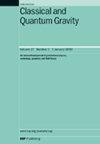Beyond ΛCDM: how the Hubble tension challenges early Universe physics
IF 3.6
3区 物理与天体物理
Q2 ASTRONOMY & ASTROPHYSICS
引用次数: 0
Abstract
Differences in the values of the Hubble constant obtained from the local Universe and the early Universe have resulted in a significant tension. This tension signifies that our understanding of cosmology (physical processes and/or cosmological data) is incomplete. Some of the suggested solutions include physics of the early Universe. In this paper we aim to investigate common features of various early-Universe solutions to the Hubble constant tension. The physics of the early Universe affects the size of the sound horizon which is probed with the Cosmic Microwave Background data. Within the standard model, the size of the horizon (within limits of current measurements) is affected by processes that could occur between (approximately) 1 d after the Big Bang and the last scattering instant. We focus on simple extensions incorporating Early Dark Energy (EDE) and show how such a model affects the inferred values of the Hubble constant. We compare this model to ΛCDM models using MCMC analysis, likelihoods over the parameter space and Bayesian evidence. The MCMC analysis shows that EDE leads to a decrease in the size of the sound horizon that is consistent with km s−1 Mpc−1 but we also show that MCMC analysis favours increasing redshift and proportion of EDE. The Bayesian evidence favours our EDE model for very narrow, finely-tuned parameter space. The ΛCDM model used for comparison has good evidence across a wide parameter space. We interpret this as an indication that more sophisticated models are required. We conclude that if the Hubble tension were to be related to the physics of the early Universe, EDE could be used as a window to explore conditions of the early Universe and extend our understanding of that era.超越ΛCDM:哈勃张力如何挑战早期宇宙物理学
从本地宇宙和早期宇宙获得的哈勃常数值的差异导致了显著的紧张。这种张力表明我们对宇宙学(物理过程和/或宇宙学数据)的理解是不完整的。一些建议的解决方案包括早期宇宙的物理学。在本文中,我们的目的是研究哈勃常数张力的各种早期宇宙解的共同特征。早期宇宙的物理特性影响了用宇宙微波背景数据探测到的声视界的大小。在标准模型中,视界的大小(在当前测量范围内)受到可能发生在大爆炸后(大约)1天到最后散射瞬间之间的过程的影响。我们将重点放在包含早期暗能量(EDE)的简单扩展上,并展示这样的模型如何影响哈勃常数的推断值。我们使用MCMC分析、参数空间上的似然和贝叶斯证据将该模型与ΛCDM模型进行比较。MCMC分析表明,EDE导致声视界大小的减小,这与km s−1 Mpc−1一致,但我们也表明MCMC分析有利于增加EDE的红移和比例。贝叶斯证据支持我们的EDE模型用于非常窄的、微调的参数空间。用于比较的ΛCDM模型在广泛的参数空间中具有良好的证据。我们将此解释为需要更复杂的模型的指示。我们的结论是,如果哈勃张力与早期宇宙的物理学有关,那么EDE可以作为探索早期宇宙条件的窗口,并扩展我们对那个时代的理解。
本文章由计算机程序翻译,如有差异,请以英文原文为准。
求助全文
约1分钟内获得全文
求助全文
来源期刊

Classical and Quantum Gravity
物理-天文与天体物理
CiteScore
7.00
自引率
8.60%
发文量
301
审稿时长
2-4 weeks
期刊介绍:
Classical and Quantum Gravity is an established journal for physicists, mathematicians and cosmologists in the fields of gravitation and the theory of spacetime. The journal is now the acknowledged world leader in classical relativity and all areas of quantum gravity.
 求助内容:
求助内容: 应助结果提醒方式:
应助结果提醒方式:


